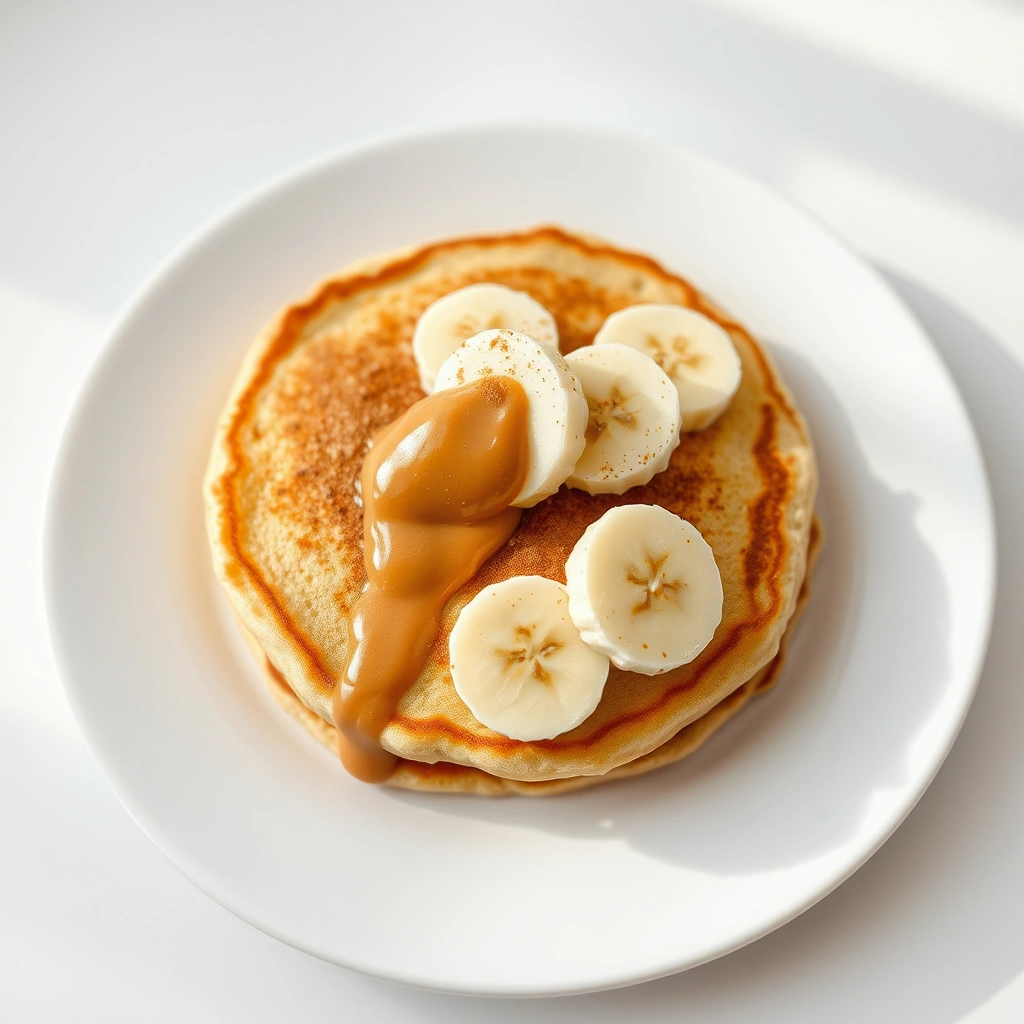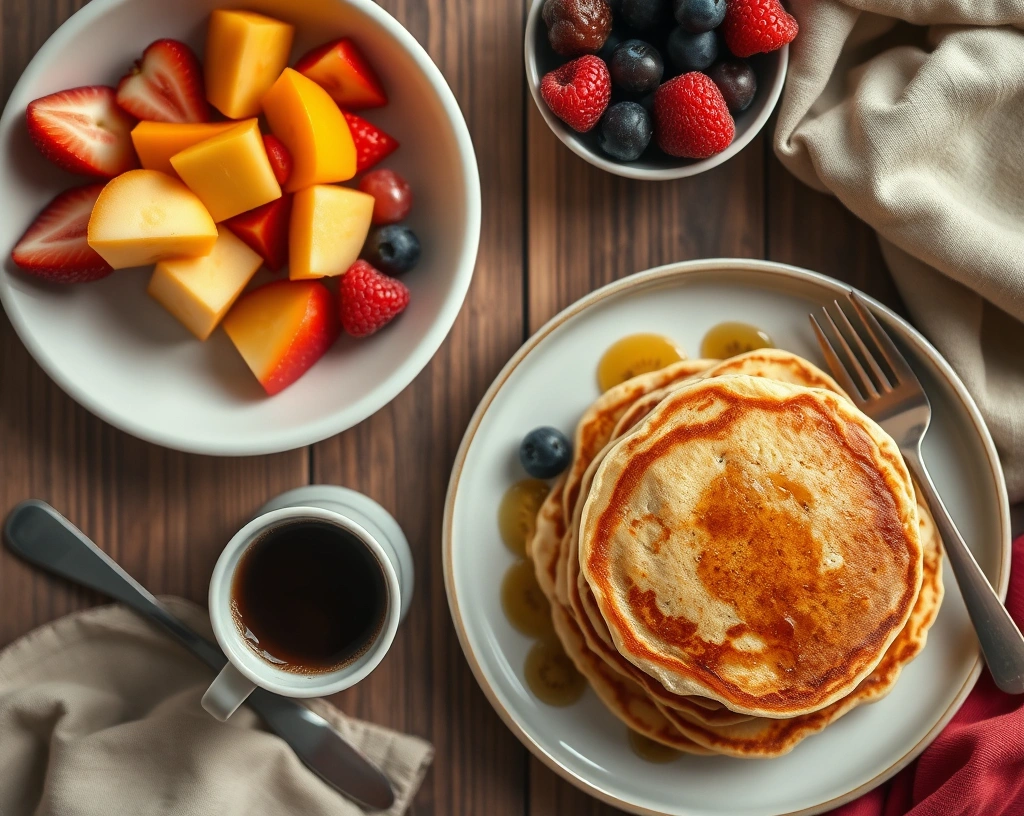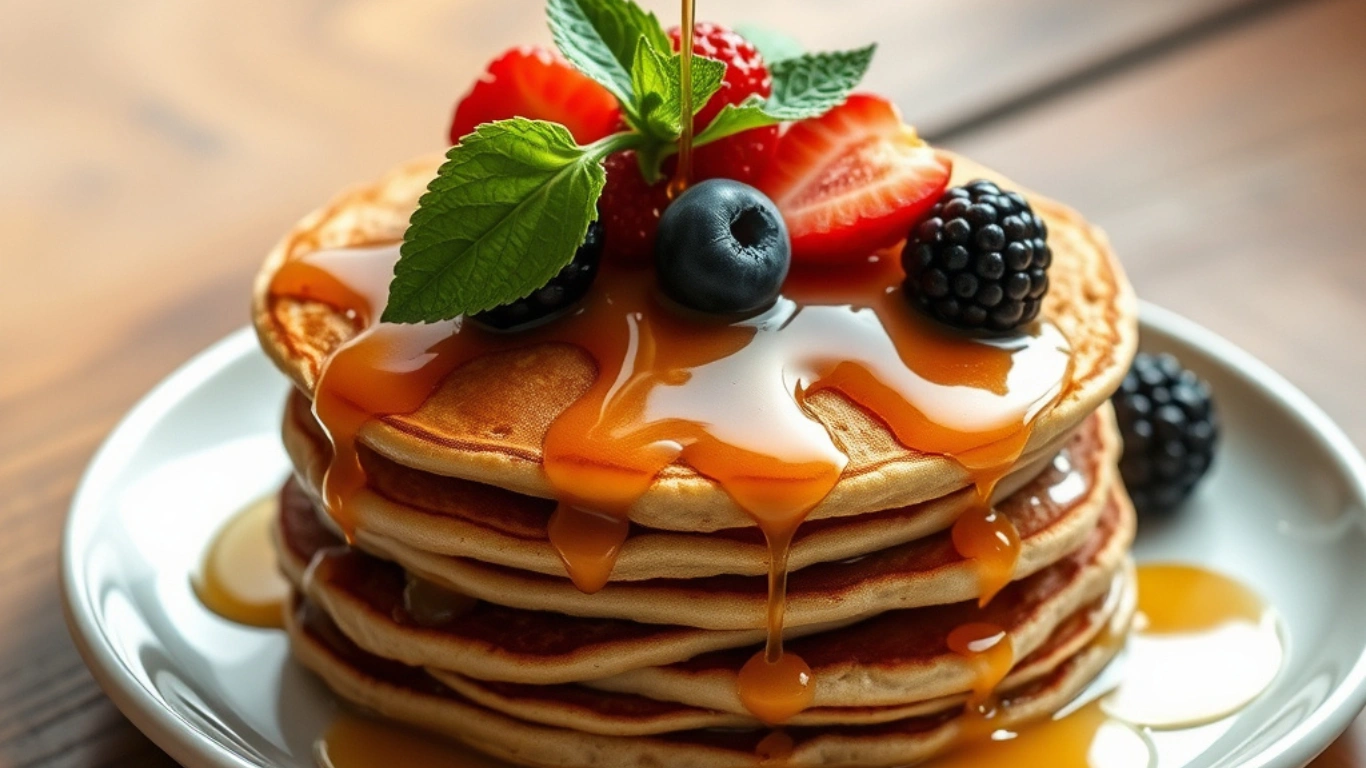Vegan Pancake Recipe: A Fluffy, Delicious, Plant-Based Treat
Who doesn’t love pancakes? Whether it’s a lazy weekend breakfast or a quick weekday meal, pancakes always bring joy. But what if they could also be vegan, healthier, and just as fluffy? This article dives into everything you need to know about making the perfect vegan pancake recipe. From essential ingredients and step-by-step instructions to common mistakes and creative toppings, we cover it all. By the end, you’ll have a go-to recipe that’s easy, adaptable, and guaranteed to satisfy, much like other delicious options in vegan brunch recipes.
What Is a Vegan Pancake Recipe?
Introduction to Vegan Pancakes
Vegan pancakes are a plant-based twist on the classic breakfast dish. They’re made without eggs, milk, or other animal-based ingredients, yet they’re just as soft, fluffy, and delicious. Instead of traditional ingredients, vegan pancakes rely on plant-based substitutes like almond milk, applesauce, and flaxseed. These swaps make the recipe suitable for vegans and those with dietary restrictions, as demonstrated in recipes like vegan gluten-free pancakes and other adaptable plant-based options.
Why Choose Vegan Pancakes?
There are plenty of reasons to choose a vegan pancake recipe. They’re kinder to the planet, using plant-based ingredients that reduce environmental impact, as highlighted in vegan brunch recipes. Vegan pancakes are also healthier, often containing less cholesterol and saturated fat than traditional versions. Plus, they’re incredibly versatile, allowing you to experiment with flavors, add-ins, and toppings. Whether you’re vegan or simply curious about plant-based cooking, these pancakes offer a delicious and sustainable way to start your day.
Essential Ingredients for Vegan Pancakes
Common Ingredients
To create the perfect vegan pancake recipe, you need simple and easily available ingredients. Use all-purpose flour, whole wheat flour, or gluten-free flour, depending on your preference. Choose plant-based milk like almond milk, soy milk, or oat milk for a creamy consistency. Natural sweeteners, such as maple syrup or agave nectar, provide a subtle sweetness. Baking powder and baking soda make the pancakes rise and give them their light, fluffy texture.
Egg Substitutes
Vegan pancakes don’t need eggs, thanks to effective plant-based alternatives. Mixing one tablespoon of ground flaxseed or chia seeds with three tablespoons of water creates a gel that works perfectly as an egg replacement. Applesauce or mashed bananas are also excellent options, serving as natural binders while adding moisture and subtle sweetness. These substitutes enhance the texture and flavor of the pancakes, as seen in vegan gluten-free pancake recipes and other plant-based breakfast ideas.
Flavor Enhancers and Add-ins
You can easily customize vegan pancakes to suit your taste. Add a splash of vanilla extract to enhance sweetness, or sprinkle in a dash of cinnamon for warmth. Include fresh fruits like blueberries or strawberries to add bursts of flavor and color. For a crunchier texture, mix in chopped nuts or shredded coconut. Vegan chocolate chips can also make your pancakes a delightful treat for any occasion.
With these simple ingredients and creative options, vegan pancakes are both easy to make and highly customizable to fit your preferences.
Step-by-Step Vegan Pancake Recipe

Ingredients List
To prepare a batch of fluffy vegan pancakes, gather these ingredients:
- 1 cup all-purpose flour (or whole wheat flour)
- 2 tablespoons sugar (or coconut sugar)
- 2 teaspoons baking powder
- 1/4 teaspoon salt
- 1 cup plant-based milk (almond, soy, or oat milk)
- 1 tablespoon flaxseed or chia seed mixed with 3 tablespoons water (as an egg substitute)
- 1 teaspoon vanilla extract
- 1 tablespoon melted coconut oil or neutral oil
- Optional: Fresh blueberries, chocolate chips, or nuts for mix-ins
Preparation Steps
- Prepare the Egg Substitute
In a small bowl, combine flaxseed or chia seeds with water. Let the mixture sit for five minutes until it thickens into a gel-like texture. - Combine Dry Ingredients
In a large mixing bowl, whisk together the flour, sugar, baking powder, and salt. Mixing the dry ingredients first ensures an even distribution of leavening agents for fluffy pancakes. - Mix Wet Ingredients
In another bowl, combine the plant-based milk, prepared flaxseed mixture, vanilla extract, and melted coconut oil. Stir until everything blends smoothly. - Create the Batter
Gradually pour the wet ingredients into the dry ingredients. Gently fold the mixture until just combined. Avoid overmixing, as this can result in dense pancakes. If desired, fold in optional add-ins like blueberries or chocolate chips at this stage. - Preheat the Pan
Heat a non-stick skillet or griddle over medium heat. Lightly grease the surface with oil or vegan butter to prevent sticking. - Cook the Pancakes
Scoop 1/4 cup of batter onto the skillet for each pancake. Cook until bubbles form on the surface and the edges look set, about 2-3 minutes. Flip and cook the other side until golden brown, approximately 2 minutes. - Serve Hot
Transfer the cooked pancakes to a plate and keep them warm while cooking the remaining batter.
Tips for Success
- Use a non-stick skillet or griddle for the best results.
- Let the batter rest for a few minutes before cooking to ensure even hydration.
- Keep the heat moderate to avoid burning while ensuring thorough cooking.
Variations to Try
- Gluten-Free Pancakes: Use a gluten-free flour blend instead of all-purpose flour.
- Banana Pancakes: Add 1/4 cup mashed banana to the wet ingredients for natural sweetness.
- Chocolate Chip Pancakes: Mix in 1/2 cup vegan chocolate chips for a rich, indulgent flavor.
Nutritional Information (per 100g)
| Calories | Protein (g) | Carbs (g) | Fat (g) |
|---|---|---|---|
| 220 | 4 | 32 | 7 |
Common Mistakes to Avoid
Overmixing the Batter
One of the most common mistakes in making vegan pancakes is overmixing the batter. Stirring too much activates the gluten in the flour, which results in dense and chewy pancakes instead of light and fluffy ones. To avoid this, gently fold the wet and dry ingredients together until just combined. Small lumps in the batter are perfectly fine and will disappear during cooking.
Incorrect Heat Settings
Cooking pancakes at the wrong temperature can lead to uneven results. If the heat is too high, the outside of the pancakes may burn while the inside remains undercooked. Conversely, low heat may cause the pancakes to spread too much and take longer to cook. Always preheat your skillet over medium heat and adjust as needed to maintain an even temperature.
Using the Wrong Pan
A good-quality non-stick skillet or griddle is essential for making perfect pancakes. Using a pan that sticks or heats unevenly can make flipping the pancakes difficult, resulting in broken or misshapen pieces. Lightly greasing the pan with oil or vegan butter before each batch also ensures the pancakes cook evenly and don’t stick.
Ignoring the Resting Time
Skipping the resting time for the batter can affect the texture of your pancakes. Allowing the batter to sit for a few minutes helps the ingredients hydrate fully, resulting in thicker, fluffier pancakes.
By avoiding these common mistakes, you’ll achieve consistently perfect pancakes with a soft texture, golden-brown color, and great flavor.
Topping Ideas for Vegan Pancakes

Classic Toppings
Traditional toppings can elevate the flavor of your vegan pancakes without much effort. Maple syrup is a timeless choice, offering sweetness that pairs perfectly with the fluffy texture of the pancakes. Fresh fruits like sliced bananas, strawberries, or blueberries add both flavor and nutrition. A light dusting of powdered sugar provides a simple yet elegant finishing touch.
Nutty and Creamy Options
For those who love a rich, creamy texture, nut butters like almond or peanut butter make excellent toppings. Spread a thin layer of your favorite nut butter over the pancakes for a dose of protein and healthy fats. Coconut yogurt or plant-based whipped cream adds creaminess while keeping the dish dairy-free. For added crunch, sprinkle chopped nuts like walnuts, almonds, or pecans over the pancakes.
Gourmet Toppings
Gourmet toppings can transform your pancakes into a decadent treat. Caramelized bananas, made by sautéing banana slices with a bit of coconut sugar, create a rich, buttery flavor. Fruit compotes, such as warm berry sauce or apple cinnamon compote, add a tangy sweetness. For chocolate lovers, a drizzle of melted vegan chocolate or a sprinkle of cacao nibs makes the pancakes feel indulgent.
With these topping ideas, you can customize your pancakes to match any mood or occasion, ensuring a delightful experience every time.
Benefits of Making Vegan Pancakes
Health Benefits
Making vegan pancakes offers several health advantages compared to traditional recipes. By excluding dairy and eggs, these pancakes are cholesterol-free, which supports heart health. Using plant-based ingredients like almond milk and whole-grain flour adds fiber and essential nutrients to the recipe. These pancakes are often lower in saturated fat, especially if you replace oil with applesauce or mashed bananas. Natural sweeteners like maple syrup or coconut sugar also keep the sugar content in check, making them a healthier option for breakfast or snacks.
Environmental Benefits
Vegan pancakes are not only healthier but also kinder to the environment. By using plant-based ingredients, the recipe avoids the high carbon footprint associated with animal-based products like eggs and dairy. Overripe bananas, a common ingredient in vegan pancakes, also help reduce food waste, contributing to sustainable cooking practices.
Adaptability for Dietary Needs
One of the greatest benefits of vegan pancakes is their adaptability. The recipe can easily be adjusted to accommodate various dietary restrictions, such as gluten-free or low-sugar preferences. Substituting all-purpose flour with gluten-free options, as shown in vegan gluten-free pancake recipes, or replacing refined sugar with natural sweeteners like maple syrup or agave makes the dish accessible to a wider audience. These adjustments ensure the pancakes retain their delicious taste and fluffy texture without compromising on dietary needs.
By embracing these benefits, vegan pancakes become a versatile, eco-friendly, and nutritious choice for any breakfast table.
Storing and Reheating Vegan Pancakes
Storing Pancakes
Proper storage keeps vegan pancakes fresh and ready for future meals. If you plan to enjoy them within a day or two, store leftover pancakes in an airtight container at room temperature. For longer storage, place them in the refrigerator, where they can last up to five days. To prevent sticking, separate the pancakes with parchment paper or wax paper.
For extended storage, freezing is an excellent option. Allow the pancakes to cool completely, then stack them with parchment paper between each pancake to avoid sticking. Place the stack in a freezer-safe bag or container, removing as much air as possible before sealing. Frozen pancakes can stay fresh for up to three months.
Reheating Pancakes
Reheating vegan pancakes is straightforward and helps them retain their soft and fluffy texture. For a quick method, heat individual pancakes on a microwave-safe plate for 20–30 seconds. If you prefer a crispier texture, use a toaster or toaster oven to warm the pancakes for a few minutes. Alternatively, reheat them on a skillet over low heat, flipping occasionally until evenly warmed. These methods ensure the pancakes taste fresh, just like they did when first made, as shown in vegan pancake recipes.
With these storage and reheating tips, you can prepare a batch of pancakes in advance and enjoy them throughout the week without compromising their quality or taste.
Frequently Asked Questions (FAQs)
Can Vegan Pancakes Be Made Gluten-Free?
Yes, you can make vegan pancakes gluten-free by substituting regular flour with gluten-free alternatives. Popular options include a gluten-free all-purpose flour blend, oat flour, or almond flour. For best results, add a bit more liquid to balance the consistency, as some gluten-free flours absorb more moisture than traditional flour.
How Do I Replace Eggs in Pancakes?
Eggs can be replaced with simple, plant-based alternatives that work just as well. Mix one tablespoon of ground flaxseed or chia seeds with three tablespoons of water to create a gel-like substitute for one egg. Applesauce, mashed bananas, or even plant-based yogurt are other effective egg substitutes, adding both moisture and flavor.
What’s the Best Way to Cook Pancakes Without Sticking?
Using a high-quality non-stick skillet or griddle is key to preventing pancakes from sticking. Lightly grease the surface with a small amount of oil or vegan butter before pouring the batter. Ensure the skillet is evenly heated on medium heat for consistent cooking and an easy flip.
Can I Make Pancake Batter Ahead of Time?
Yes, pancake batter can be prepared ahead of time. Store the batter in an airtight container in the refrigerator for up to 24 hours. Before using, stir the batter gently, as some ingredients may settle at the bottom. For best results, cook the pancakes immediately after taking the batter out of the fridge.
How Do I Ensure Fluffy Pancakes Without Eggs?
Achieving fluffy vegan pancakes without eggs is easy with the right techniques. Use baking powder and baking soda to create a light, airy texture. Letting the batter rest for a few minutes before cooking allows the leavening agents to activate, resulting in fluffier pancakes. Avoid overmixing, as this can make the pancakes dense.
Conclusion
Recap of the Vegan Pancake Recipe
Vegan pancakes are a delicious, versatile, and healthier alternative to traditional pancakes. By using plant-based ingredients like almond milk, flaxseed, and natural sweeteners, you can create a stack of fluffy and flavorful pancakes suitable for everyone. This recipe is adaptable, allowing you to customize it with gluten-free flours, fresh fruits, or decadent toppings like vegan chocolate chips.
Inspiration to Try Variations and Toppings
With so many options for ingredients and toppings, vegan pancakes are a recipe you can experiment with endlessly. From caramelized bananas to fruit compotes, each topping adds a unique twist, as seen in vegan brunch recipes, making your pancakes perfect for any occasion. Whether you’re preparing breakfast for your family or seeking a plant-based treat, this recipe delivers delicious results every time while remaining adaptable to your preferences.
Enjoy the simplicity, health benefits, and incredible flavor of this vegan pancake recipe, and make it a staple in your breakfast routine!
